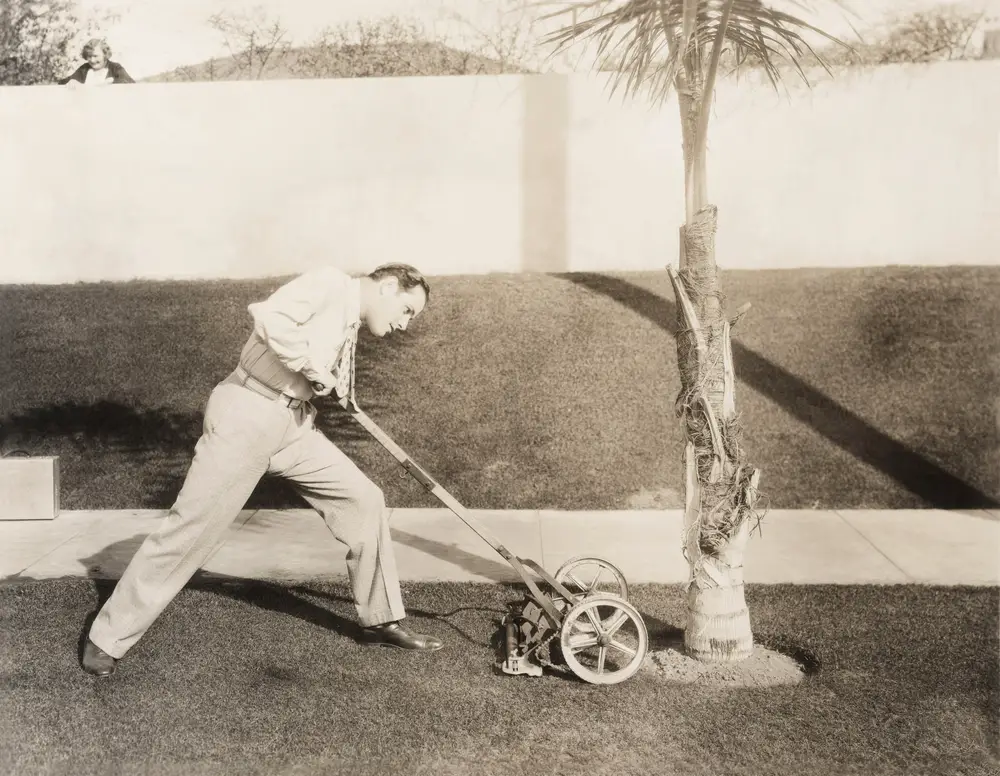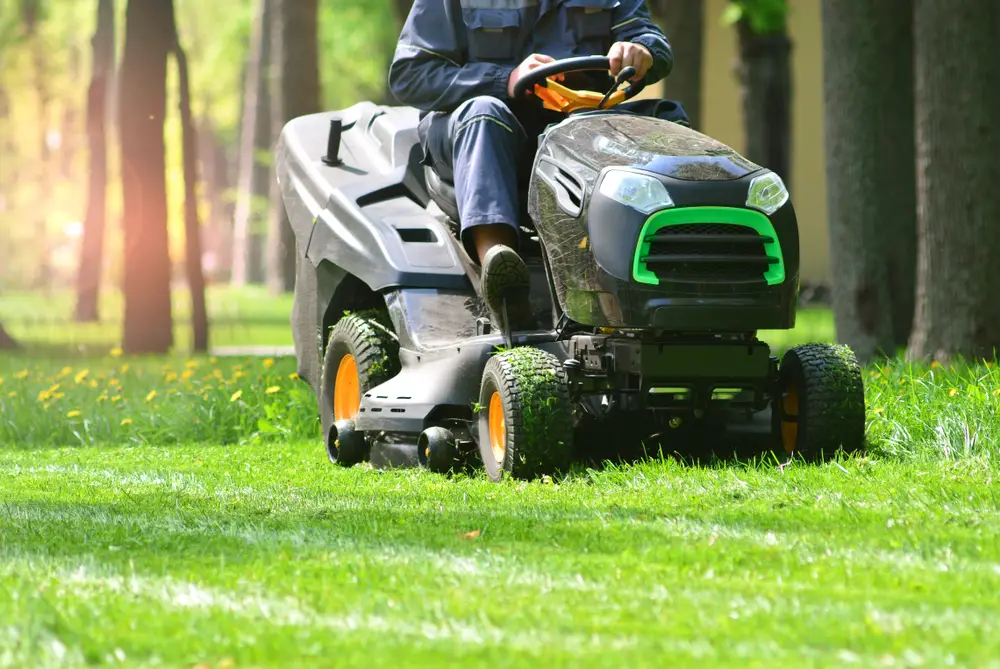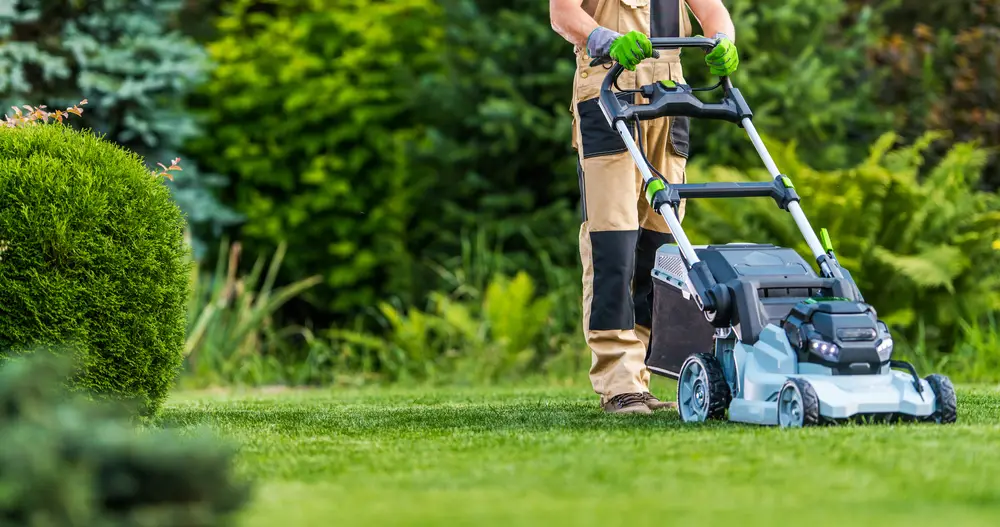It is always good to reflect on the times and products that have been in our lives for as long as we can remember. Technology has grown over the centuries and made using lawn mowers easier and more fun throughout all big names like John Deere, Craftsman, Gravely, Hustler, and others. Each company thrives on the latest technologies to claim its product is better than the competition. So, what are today’s technologies that have been added to lawn mowers?
Today’s technologies added to lawn mowers are brushless motors, GPS, remote control, Bluetooth, USB ports, LED lights, seat suspensions, hydraulic systems, hour meters, noise reduction systems, automatic speed control, mulching capabilities, floating decks, and self-propelled drive.
In this content you’ll learn:
The Evolution Of Lawn Mowers For Almost Two Centuries

Let’s take a step back through a brief timeline and look at the first riding lawn mowers. We must look at this timeline first to understand and appreciate today’s technology. Horses pulled some lawn mowers, which makes sense since plows inspired the design. Years passed and they became easily accessible by a push-behind lawn mower.
Edwin Budding built the first lawn mower in 1830 in England. Its blades rotated as if around a cylinder, and they cut the grass like a pair of scissors. This was a hand-powered reel lawn mower, and people still use the design today.
The next significant step in riding lawn mower technology didn’t occur for another 100 years. In 1832, Ransomes introduced the Auto-Mow Gang Mower. This was the world’s first commercially available gang mower, and it could cut large areas of grass quickly and efficiently. The machine had a petrol or gasoline engine that a single person could drive.
Self-Propelled Rotary Lawn Mower
It wasn’t until the 1960s that the first self-propelled rotary lawn mower was introduced. It had a cutting deck that rotated flat and parallel. Modern rotary lawn mowers still use this design.
Hydrostatic Transmissions
The 1960s also saw the introduction of a hydrostatic transmission for lawn mowers, and it was added in the early 1970s. This transmission type is much more efficient than the mechanical ones used in earlier lawn mowers. Hydrostatic transmissions run like an automatic car where you press the foot pedal and it goes forward or reverses at its set speeds. Mechanical transmissions have a gearbox where the operator must shift into the desired gear for the lawn mower to move. Many modern lawn mowers still use hydrostatic transmissions. It wasn’t until the late ‘70s that it became affordable for homeowners to own these lawn mowers.
Zero-Turn Lawn Mowers
The 1970s saw the introduction of the zero-turn radius lawn mower. The first ones looked like traditional lawn mowers, with the front tires creating zero turns. Zero-turn lawn mowers experienced many problems with their front tires. Later designs put the back tires in charge of controlling the steering.
Zero-turn lawn mowers can make very tight turns, which helps cut around obstacles. Zero-turn radius lawn mowers are popular with professional landscapers and gardeners because they save time from shifting forward and reverse. Because of this, they cut closer next to trees and other objects.
Today’s Technologies Added To Lawn Mowers

Now that we have taken a look at the technologies used in the first lawn mowers, let’s take a look at some of the latest technologies being used in today’s lawn mowers.
Brushless Motors
One of the most significant technological advances in recent years is the development of lithium-ion batteries. Lithium-ion batteries are much more potent than lead-acid batteries and can be recharged much more quickly. The downside is if the property owner has a big yard, they may need more than one battery to complete the cut in a single cutting session. The horsepower is impressive considering the time allowed for each battery which is 1 ½ to 3 hours per charge.
Many modern cordless lawn mowers now use lithium-ion batteries. They are called brushless motors because they operate on electricity, not from the typical engine carburetor and exhaust systems. These motors are environmentally friendly and are much quieter than regular motors.
GPS And Remote Control
Another piece of technology is GPS. GPS steers a lawn mower along a pre-determined path automatically. This is very useful for massive commercial lawns that require regular mowing. There are also remote-control lawn mowers now that you can operate from sitting under a tree while enjoying your favorite cool beverage. It makes work fun, and you hardly break a sweat.
Bluetooth
Many modern lawn mowers also come with Bluetooth connectivity, which allows smartphones or tablets to control them. As mentioned in the “GPS and Remote Control” section, Bluetooth also connects the lawn mower to other devices, such as robotic lawn mowers or remote control.
Some people love to listen to music or their favorite iPod while they ride. They work great with smartphones and MP3 players. Now, you can enjoy your favorite music and slip away to another world while you mow. Just make sure the neighbors don’t see you dancing too much. They may get jealous!
USB Ports
USB ports are another common feature on today’s lawn mowers. They charge smartphones or other devices. Your smart device will stay charged if you have a big yard to mow, and you can continue to enjoy the music you love. Plus, you will never miss a call. The USB ports connect the lawn mower to a computer for diagnostics.
LED Lights
LED lights are another common feature of modern lawn mowers. They provide better illumination than traditional halogen bulbs. You can see the grass line better in the dark and shouldn’t hit anything with the added brightness. They also use less power, which is essential for battery-powered lawn mowers.
Seat Suspensions
Many modern lawn mowers also come with seat suspensions. This helps to reduce vibration and makes the lawn mower more comfortable to operate. In the old days, some of the lawn mowers didn’t have much of a cushion. Today, the seat moves along with the bumps in the yard, so it is easier on your back and rear.
Hydraulic Systems
Hydraulic systems are another common feature of modern lawn mowers. It helps for a better cut and smoother ride. Hydraulic systems raise and lower the cutting deck. They adjust the cutting height of the blades, and it eliminates the manual strain of lifting and lowering the deck. It also takes the place of the old gearboxes used on traditional lawn mowers.
Hour Meters
Hour meters started around the 1970s, but they are still a useful feature on many lawn mowers today. They keep track of how long the lawn mower has been operating. This is important for maintenance purposes. You can easily see when the lawn mower is due for a tune-up or oil change.
Noise Reduction Systems
Noise reduction systems started to become features for many lawn mowers in recent years. These systems help to reduce the noise emitted by the lawn mower. The old gas-powered lawn mowers could be loud, and it was always a good idea to wear ear protection. Today, you can operate a lawn mower without disturbing the neighbors.
Today’s Technologies Added To Lawn Mowers For Quicker Cut Times And Cleaner Cuts

The first lawn mowers went about 2 miles per hour. Some homeowners were lucky to get up to 5. Today, many lawnmowers travel around 7 to 15 miles per hour. And with the help of new technology, they’re making cleaner cuts than ever.
Lawn mower manufacturers have added several features to their products in recent years to help speed up cutting grass.
Some of these include automatic speed control, mulching capabilities, floating decks, and self-propelled drive. Let’s explore them in more detail.
Automatic Speed Control
This feature allows the user to set the speed of the blade based on the type of grass being cut. The blades will automatically adjust to provide a cleaner cut.
Mulching Capabilities
Mulching lawn mowers are designed for chopping grass clippings into small pieces that can be used as fertilizer for your lawn. This reduces the time you spend bagging clippings, making the lawn look cleaner without cutting already-cut grass.
Floating Decks
Floating decks follow the curves of the ground as the mower rides over hills, holes, and other terrains that regular decks have a hard time making a clean cut.
Self-Propelled Drive
This feature helps push the lawn mower forward, so you don’t have to. It can be beneficial if you have a large lawn or one with hilly terrain.
Conclusion: Today’s Technologies Added To Lawn Mowers
Lawn mowers have come a long way since they were first invented, and they continue to evolve with new technology and features. Today’s technologies that have been added to lawn mowers will seem like a thing of the past for the lawn mowers of the future.
What kinds of technologies do you think will be added to lawn mowers in the future? What kinds of technologies do you think should be added? Let us know your thoughts in the comments below and why you think that!

